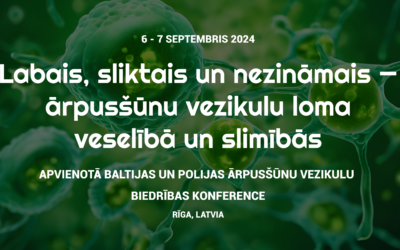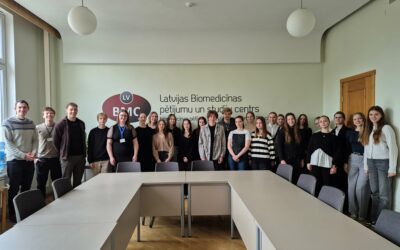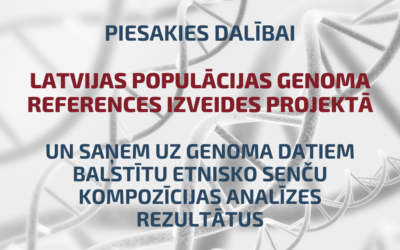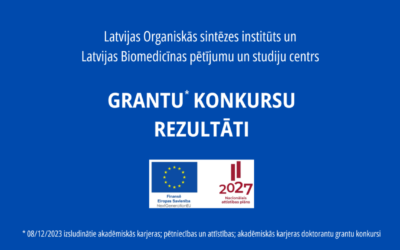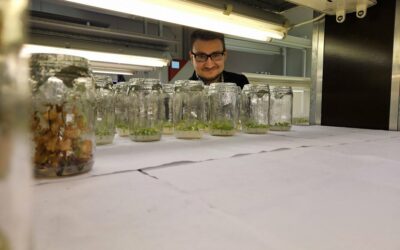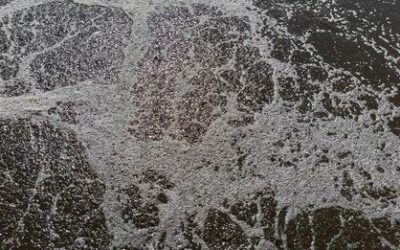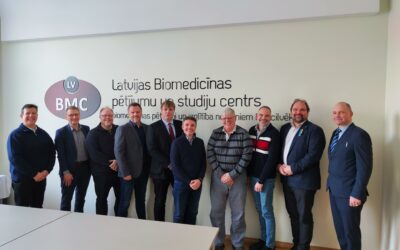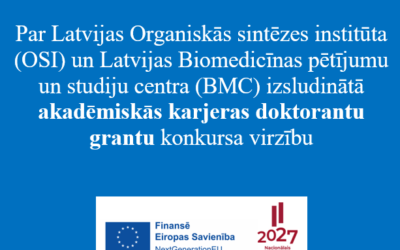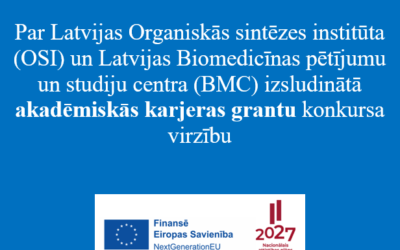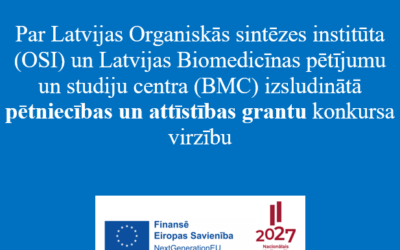Jaunumi
Labais, sliktais un nezināmais – ārpusšūnu vezikulu loma veselībā un slimībās!
Latvijas Universitāte, Baltijas Ārpusšūnu vezikulu biedrība (BSEV) un Polijas Ārpusšūnu vezikulu biedrība (PSEV) ar lepnumu aicina uz apvienoto konferenci: “Labais, sliktais un nezināmais – ārpusšūnu vezikulu loma veselībā un slimībās”, 6.-7.septembrī, 2024 Latvijas...
Promocijas darba aizstāvēšana
Šodien, 12.aprīlī Latvijas Biomedicīnas Pētījumu un Studiju centra Baltajā zālē notika LU Bioloģijas zinātņu nozares promocijas padomes atklātā sēde, kurā LILITE SADOVSKA aizstāvēja savu promocijas darbu "Ekstracelulāro vezikulu dažādās sejas vēža attīstībā" zinātnes...
Ēnu diena BMC
2024.gada 4. aprīlī arī Latvijas Biomedicīnas pētījumu un studiju centrā (BMC) notika Ēnu diena. Vairāk nekā 20 patiesi ieinteresēti jaunieši, kas plāno savu nākotni saistīt ar dabaszinātņu vai medicīnas sfēru, iepazinās ar BMC vēsturiskajām un mūsdienu laboratoriju...
Aicinām Latvijas iedzīvotājus iesaistīties Latvijas populācijas genoma references projektā
Latvijas Biomedicīnas pētījumu un studiju centrs aicina Latvijas iedzīvotājus iesaistīties Latvijas populācijas genoma references projektā, kas norit Eiropas “1+ Miljons Genomu” iniciatīvas ietvaros Projekta galvenais mērķis ir izveidot Latvijas populācijas genoma...
Priecīgas Lieldienas!
Lieldieniņas braukšus braucaAr raibām oliņām.Ar raibām oliņām,Lieliem olu groziņiem.Zaķīts - olu vedējiņš,Vistas - olu dējējiņas.Saimniecītes – krāsotājas,Raibu olu radītājas.
Nodrošināts līdzfinansējums Biofarmaceitiskās izpētes centra izveidei Latvijā
MK nolēma nodrošināt no IZM pārziņā esošo struktūrfondu līdzekļiem nacionālo publisko līdzfinansējumu projekta "Biofarmaceitiskās izpētes centrs” (turpmāk – BioReCent) īstenošanai gadījumā, ja projekts tiks apstiprināts Eiropas Savienības pētniecības un inovāciju...
OSI un BMC izsludināto grantu konkursu rezultāti
Noslēgusies Latvijas Organiskās sintēzes institūta (OSI) un Latvijas Biomedicīnas pētījumu un studiju centra (BMC) izsludināto pētniecības un attīstības un akadēmiskās karjeras grantu pieteikumu zinātniskās kvalitātes izvērtēšana un ir zināmi konkursu rezultāti. Šo...
“Iemācīties” augu valodu
Latvijas zinātnieku veiktie pētījumi liecina, ka augiem ir sava "valoda" un tie veido pazemes bioloģisko interneta tīklu, lai savā starpā sazinātos un viens otru brīdinātu par iespējamiem apdraudējumiem no kaitēkļiem un slimībām. Mūsu vadošais petnieks Zigmunds...
Mūsu zinātnieku izaugsme
2024. gads iesācies raženi, savus promocijas darbus BMC aizstāvējuši jau 3 jaunie zinātnieki Š.g. 14. februārī Latvijas Biomedicīnas Pētījumu un Studiju centra Baltajā zālē notika LU Bioloģijas zinātņu nozares promocijas padomes atklātā sēde, kurā ŅIKITA ZRELOVS...
Latvijas Biomedicīnas pētījumu un studiju centrs aicina Latvijas iedzīvotājus iesaistīties Latvijas populācijas genoma references projektā
Latvijas Biomedicīnas pētījumu un studiju centrs aicina Latvijas iedzīvotājus iesaistīties Latvijas populācijas genoma references projektā, kas norit Eiropas “1+ Miljons Genomu” iniciatīvas ietvaros Projekta galvenais mērķis ir izveidot Latvijas populācijas genoma...
Sasniegums zinātnē – uzticama notekūdeņu monitoringa sistēma
Latvijas Zinātņu akadēmija par vienu no aizvadītā gada nozīmīgākajiem sasniegumiem Latvijas zinātnē atzinusi darbu pie Notekūdeņu epidemioloģijas pētījumu jomas attīstības Covid-19 pandēmijas kontekstā. Tā rezultātā Latvijā tapusi zinātniski pamatota nacionāla mēroga...
BMC Starptautiskās konsultatīvās padomes sanāksme
2024.gada 16.-17.janvārī Latvijas Biomedicīnas pētījumu un studiju centrā (BMC) norisinājās BMC Starptautiskās konsultatīvās padomes sanāksme, kurā BMC vadība un zinātniskās grupas prezentēja 2021.-2023.gada darbības pārskatu, kā arī uzklausīja BMC Starptautiskās...
Par Latvijas Organiskās sintēzes institūta (OSI) un Latvijas Biomedicīnas pētījumu un studiju centra (BMC) izsludinātā akadēmiskās karjeras doktorantu grantu konkursa virzību
Latvijas Organiskā sintēzes institūta (OSI) un Latvijas Biomedicīnas pētījumu un studiju centra (BMC) izsludinātajā akadēmiskās karjeras doktorantu grantu konkursā saņemti un apstiprināti finansēšanai 19 akadēmiskās karjeras doktorantūras grantu iesniegumi. Konkurss...
Par Latvijas Organiskās sintēzes institūta (OSI) un Latvijas Biomedicīnas pētījumu un studiju centra (BMC) izsludinātā Akadēmiskās karjeras grantu konkursa virzību
Latvijas Organiskā sintēzes institūta (OSI) un Latvijas Biomedicīnas pētījumu un studiju centra (BMC) izsludinātajā akadēmiskās karjeras grantu konkursa kopā saņemti 60 pieteikumi, no kuriem: 40pēcdoktorantūras grantu iesniegumi – 22 no tiem sagatavojuši un...
Par Latvijas Organiskās sintēzes institūta (OSI) un Latvijas Biomedicīnas pētījumu un studiju centra (BMC) izsludinātā pētniecības un attīstības grantu konkursa virzību
Latvijas Organiskās sintēzes institūta (OSI) un Latvijas Biomedicīnas pētījumu un studiju centra (BMC) izsludinātajā pētniecības un attīstības grantu konkursā kopā saņemti 17 pētniecības un attīstības grantu iesniegumi - 9 no tiem sagatavojuši un iesnieguši OSI...

